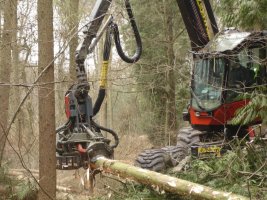Hello everyone!
Excited to join the community
We recently took on a small plot of land which has a woodland (just under and acre) planted up about 12 years ago. It has never been coppiced and it feels that now is a good time to start coppicing some areas.
I was advised by an experienced coppice manager to divide the plot up into areas, cutting down chunks of the woodland to allow light in to encourage the new growth, which makes sense. So that is what I am planning to start doing this week, taking down an area of the woodland, repeating this each year working my way through the whole woodland.
I'm nervous about being the first to cut down parts of this young woodland and although I'm fairly experienced with trees individually and that this should work, I thought I would check in here to see that this approach is right.
A chunk of the area is birch, and I know I'm getting late in winter to be cutting them due to the sap rising, but we're high up on an exposed hill and our winter is usually a month later than most of southern UK, making me think this should be OK. Otherwise, it's a mix of trees.
I was advised also to pollard rather than coppice because of rabbits and deer, but we have a deer fence and I kinda feel this could lead to unstable trees in such an exposed spot?
The other thing is that the wood is planted close together, about 1 - 1.5 m between trees and they've all grown successfully. I read that trees are better more like 2 - 3m apart so wondered if I need to thin... though I'm guessing that will happen naturally if some don't successfully regrow.
Anyway I look forward to chatting about it and sharing my experiences as we go.
Excited to join the community
We recently took on a small plot of land which has a woodland (just under and acre) planted up about 12 years ago. It has never been coppiced and it feels that now is a good time to start coppicing some areas.
I was advised by an experienced coppice manager to divide the plot up into areas, cutting down chunks of the woodland to allow light in to encourage the new growth, which makes sense. So that is what I am planning to start doing this week, taking down an area of the woodland, repeating this each year working my way through the whole woodland.
I'm nervous about being the first to cut down parts of this young woodland and although I'm fairly experienced with trees individually and that this should work, I thought I would check in here to see that this approach is right.
A chunk of the area is birch, and I know I'm getting late in winter to be cutting them due to the sap rising, but we're high up on an exposed hill and our winter is usually a month later than most of southern UK, making me think this should be OK. Otherwise, it's a mix of trees.
I was advised also to pollard rather than coppice because of rabbits and deer, but we have a deer fence and I kinda feel this could lead to unstable trees in such an exposed spot?
The other thing is that the wood is planted close together, about 1 - 1.5 m between trees and they've all grown successfully. I read that trees are better more like 2 - 3m apart so wondered if I need to thin... though I'm guessing that will happen naturally if some don't successfully regrow.
Anyway I look forward to chatting about it and sharing my experiences as we go.


